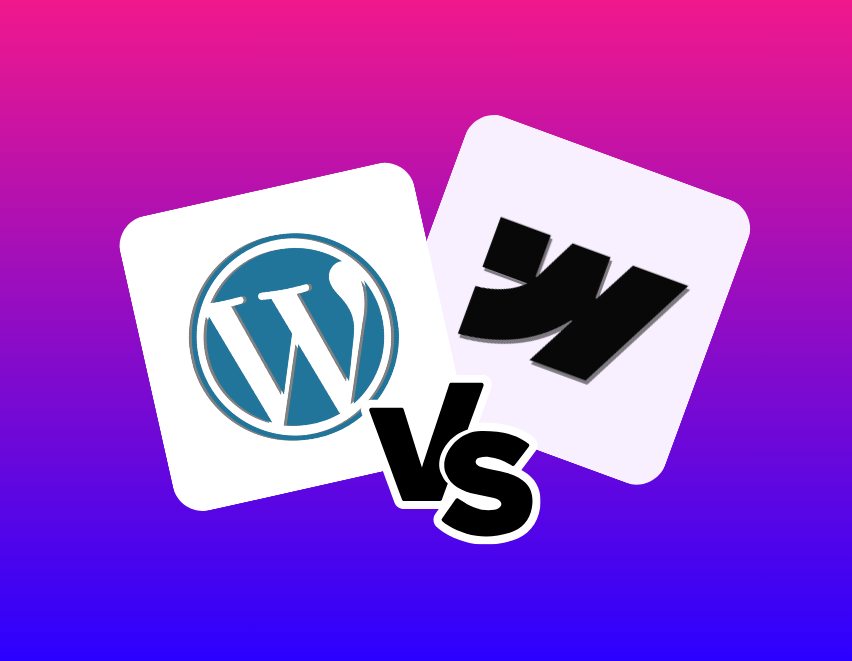There are so many website builders to choose from, but most of our clients use either Webflow or WordPress. Despite having similar functionality, they’re markedly different products—which is why today we’re comparing the two so you can see which is right for your business.
Webflow… is easier to set up
As a cloud-based all-in-one SaaS product, Webflow has everything you need to get your website live.
It’s easy to get your account set up: simply follow the step-by-step tutorial. A short survey will assess your level of coding experience, asking you a few questions about your knowledge of CSS and HTML. Then the Webflow bot walks you through using the tool, highlighting the most important areas you’ll need to know about and what they do. You can click to read more, or start building your site when you’re ready to go.
WordPress entails a clunkier setup, not least because it won’t be hosting your website as part of a package and therefore you’ll need to find and pay separately for a host and domain—and identifying a suitable host can be tricky.
Once you have your host, you download WordPress as a one-size-fits-all version which comes with instructions for installation described as ‘basic’—although many non-developers might feel otherwise.
While many web hosts offer WordPress installer tools to simplify the process, it’s never going to be as easy or seamless as an all-in-one package like Webflow.
WordPress… is free (in its basic form)
WordPress is an open-source web platform, so it’s free to use—technically. But you still have to pay a third party to use WordPress—for hosting, domain name, and usually plugins and templates (which WordPress calls themes). This is assuming you don’t have a web developer to design and build your site from scratch—but of course, dev time is also far from free!
Your total expenditure for a WordPress website can creep up if you’re after something more than basic, because of the associated costs:
- custom domain: $10–$30 a year
- hosting provider: $2–$15 a month
- preset theme: some are free, some cost up to $200 a month—or alternatively, you may wish to go all-out and hire a designer
- plugins: many are free, but premium plugins cost $40–$200
To be clear, Webflow isn’t free either, but one upside to the platform is that you pay for everything you need to build and host your website in a handy monthly package. The price you pay depends on the tier of the package, but you’ll always know upfront what it’s going to cost:
- Basic package: $14 a month, billed annually
- Standard eCommerce package: $29 a month, billed annually
- Business package: $39 a month, billed annually
- Advanced eCommerce package: $212 a month, billed annually
Webflow billing is split into two categories: Your site and Workspace—but as the Workspace is where you build and manage websites, the latter billing category is mainly for consultants working on multiple website projects at once.
Webflow… is more accessible to non-developers
If you’ve never built a website before, Webflow will ease you in—especially if you’re a designer or content manager, as the platform is visually oriented and requires almost zero code.
If you’re not using a preset template, you’ll build using drag-and-drop building blocks called containers to construct the various sections of your website. Within these containers are elements, like headings, buttons and images, which you style using classes.
With Webflow, the code is still there, and you can access it if you want, but you can build and manage your website without ever having to look at it, too. But if you tried building a WordPress site without a preset theme and no coding experience, you’d probably never get the thing off the ground. However, as WordPress’s preset themes are fairly inflexible, you’ll get more out of them if you know at least a little HTML. You can integrate a visual drag-and-drop design builder plugin like Elementor on WordPress—making it work more like Webflow, incidentally—but you’d need to pay for the plugin package, which is where the endeavour might start getting pricey.
WordPress… is better for blog hosting
There’s a reason so many blogs are hosted on WordPress: that was the platform’s original raison d’être when it was launched back in 2003.
WordPress is incredibly easy to work with when it comes to blogging. With its Gutenberg editor you can build blogs using blocks, which contain text and other media. It’s a simple and intuitive system.
While Webflow does have a CMS package, it can’t hold a candle to WordPress. Its editor isn’t the easiest to use, and it lacks many of WordPress’s advanced features, such as the comments section, and the ability to categorise and add multiple tags to posts. Webflow just isn’t built with content-driven businesses in mind—which is totally fine if that’s not what you’re about, although even then it’s worth bearing in mind in case you want to build out your blog in the future.
Webflow… offers customer support
Because you’re paying a monthly fee for Webflow, you benefit from new features, continual product improvements and customer support, the latter being especially handy if you don’t have in-house developers to call on when something goes wrong.
WordPress, on the other hand, is an open-source platform, so there’s no customer support available. That being said, the platform’s been going so long that a raft of free resources has accumulated on easily accessible websites like WPBeginner, although naturally nothing compares to realtime assistance from a dedicated customer support team as you’ll enjoy with Webflow.
WordPress… caters better to marketers
If you have a team of marketers who will be working on your website daily, WordPress is the platform for you, not least because it can handle an unlimited number of users.
Webflow enables you to edit on-page, which is a nice touch, whereas on WordPress you always need to make changes to pages via the CMS dashboard. But generally, Webflow simply isn’t built to support the level of activity possible on WordPress. With its CMS package you can have up to three ‘guest editors’, but the free and Basic packages don’t allow any editors whatsoever, meaning you’ll also be working from a single login. With the most expensive package you can have up to 10 editors. (Technically you can have more if you opt for a custom plan, but that’s when things start getting seriously pricey.) Even the nomenclature of guest editors speaks to the fact that Webflow considers marketers from within the company using the CMS as ‘guests’ to the website.
The two platforms’ different approaches to SEO optimisation also reflect their target users. Much of the SEO performance on Webflow is generated automatically, negating most of the manual work. You simply define a pattern using things like title tags and meta descriptions, then all pages in that collection will use that pattern to generate SEO settings automatically. This setup suits designers who don’t want to be thinking about writing metatags and other SEO-related tasks.
Meanwhile, over on WordPress is the Yoast plugin, which is either free or $99 annually for the premium version. This caters far more for marketers, because rather than doing anything automatically Yoast highlights keywords and guides you to create higher-quality content that’s as SEO-friendly as possible.
Webflow… offers more design freedom
Webflow is aimed at those with little or even no coding experience, often visually oriented designers and marketers who don’t want to be limited by code. Webflow therefore gives you a lot of freedom to design your website. You have the same level of customisation on WordPress too, of course, but if you’re not confident with coding then you’ll need a developer’s help to realise your vision.
Because of this setup, Webflow has far fewer preset templates than WordPress—1,000 vs 10,000 respectively. WordPress’s templates are out-of-the-box, whereas with Webflow’s templates you need to want total control and freedom over designing your website yourself.
Making changes to your Webflow design is easier post-build than on WordPress. Webflow utilises classes to style elements, such as headings, buttons and images, and you name each class—Big heading, Medium heading, Small heading, for example. Then if you want the text to be bigger for all your Big headings, you simply search for the class in the righthand menu, where you can make changes to its size, spacing and layout. These alterations are then applied automatically across all elements using that class. You can do this with CSS in WordPress, but the platform doesn’t offer no-code design tweaks unless you integrate a visual drag-and-drop design plugin.
WordPress… integrates better with other tools
WordPress is specifically designed to be used with plugins, and at present there are 60,000 available. WordPress plugins make integrations native: you don’t need to leave the platform to add them—simply go to the plugin menu on the dashboard and browse the thousands of options. Installation is performed with a single click!
In contrast, the premise of Webflow is that you have everything you need ready to go in a single handy package—no need to integrate any add-ons. You can still pull other tools into your Webflow website using code snippets, whereby you embed code into the backend of your site—but since Webflow’s strength lies in the fact you barely need code to manage your site, these code snippets are a workaround at best. Moreover, you’ll need to work with the third-party software separately, as it won’t be fully integrated into Webflow.
Webflow vs WordPress: which should you choose?
Webflow is the website builder for you if:
- whoever’s building your site has little to no coding experience
- you want to get your website up and running fast and with minimal effort
- you’re new to website building and would benefit from customer support
- you want to be able to make custom design changes to your website without having to call on a developer
…Whereas WordPress will be right for you if:
- you have coding experience or the budget to hire a web developer
- you have an existing tech stack you want to integrate into your website
- you have a team of editors or marketers who will be contributing regularly
- you want to host a blog or plan to frequently add new content pages to your site
Choosing between Webflow and WordPress depends on your budget, objectives, the experience of who’s building your website, what you plan to use the website for, and who will be editing and managing it. Both platforms are fantastic at what they do, and as long as you understand the inherent limitations of whichever you opt for, you’ll have a fabulous and SEO-worthy website going live in no time at all!






